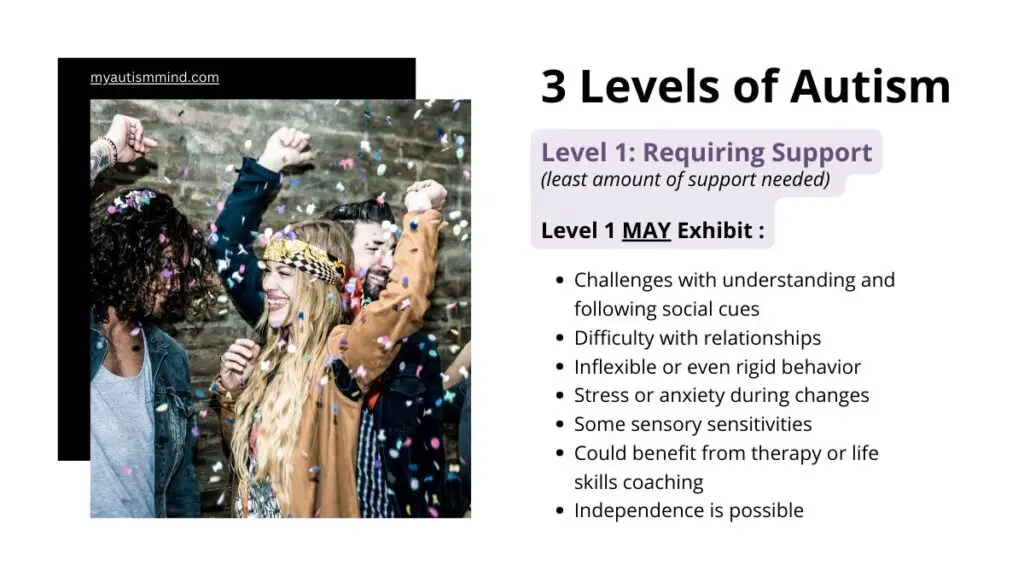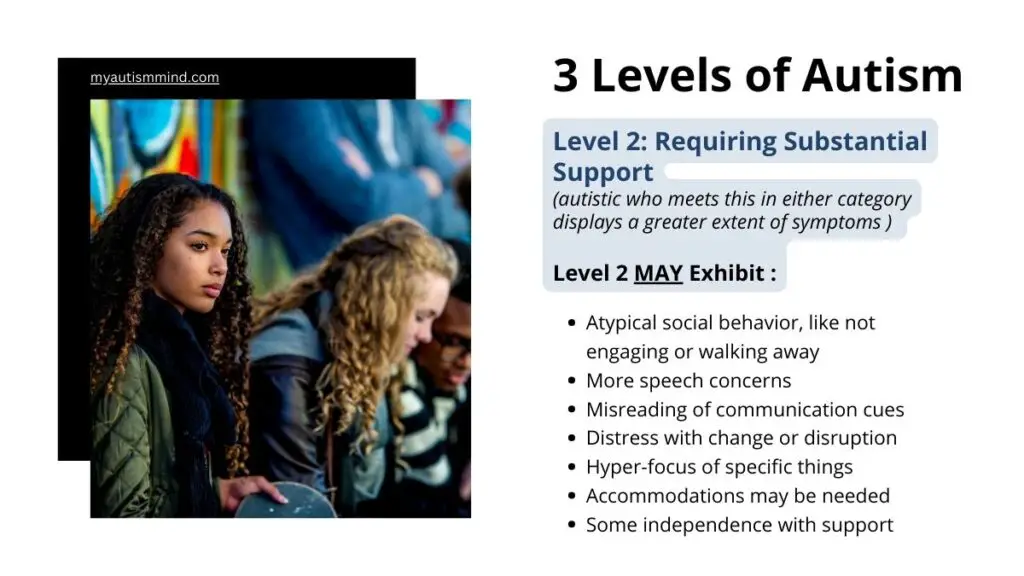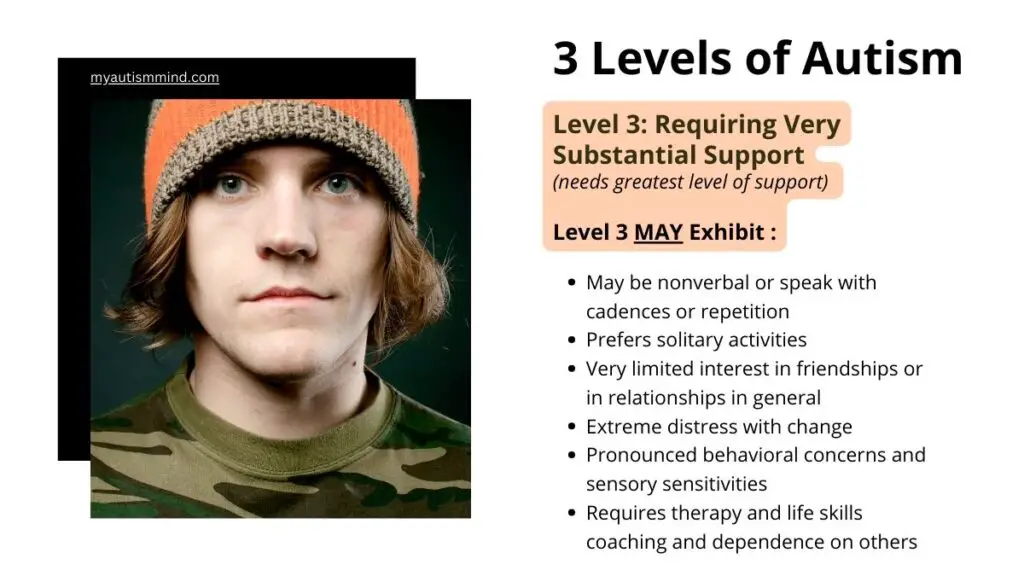Spotlight on the Spectrum: Understanding 3 Levels of Autism
You may know already know that autism is a neurodevelopmental disorder that affects every individual differently. That is why autism has now been placed under the larger category of autism spectrum disorder.
But to dig deeper, what you may not be aware of is that there are 3 levels of autism used for diagnostic criteria. These criteria of levels of autism may rank differently for each, depending on a person’s unique attributes and support needed or wanted. They are based on two categories:
- Social communication
This is how a person communicates with and relates to other people and how autistic people interacts with the world around them.
- Restricted interests / repetitive behaviors
This has to do with behaviors like stimming, obsession, rigidity with schedules, and sensory sensitivities.
These criteria are based on types of autism (remember there is now a “spectrum”), but on levels of autism and what types of autism characteristics may be presenting in a person.
If the types of autism have been folded into one umbrella term of autism spectrum disorder, then why are two criteria used to establish the 3 levels of autism? It almost sounds like alphabet suit to a layman, but it’s explanation is pretty simple.
RELATED: Do You Know Your Flavor of Autism Spectrum Disorders?
Why Are Levels of Autism Needed?

For example, in terms of social communication, it’s important to realize some autistics are great conversationalists, but may struggle with interpreting social cues.
Others may struggle with having a back-and-forth communication with others and may shy away from talking with others as a result. There are also those autistics who may be nonverbal, or communicate without sensors and often have emotional outbursts when they disagree with something being said.
But those challenges are very different than someone with behaviors issues or have extremely restricted interests. Someone with these needs may be fine with communications, but may exhibit extreme rocking or stimming behaviors, have great stress and anxiety when needing to make eye contact or to go to unfamiliar or crowded places, and have OCD and/or ADHD co-occurring conditions that impact daily life.
Because of the uniqueness of neurodiversity, a person can have different levels of autism based on those two criteria. They could be a level 3 for social communication with much support needed, but a level 1 with behaviors / restricted interests, meaning they really don’t require much or any support at all.
In the end, it’s important to realize that assigning numbers to the types of autism support needed is not to label the person, but only to help that individual get the proper amount of support that is right and helpful for them.
It’s also to remember that a diagnosis can be helpful at any age or stage, and that it’s never too late (actor Anthony Hopkins was in his late 70s when he was diagnosed). There are numerous undiagnosed adults on the spectrum (men or women alike) or ones who don’t get diagnosed until late in life.
RELATED: Labels and Names – Why Labeling People Leads to Discrimination
The 3 Levels of Autism Explained
Autism occurs on a spectrum, with different people exhibiting different symptoms and levels of severity. Broadly speaking, here are 3 levels of autism:
Level 1 – Requiring Support (Also Called Mild)

They generally have good language skills, although they may struggle to fully participate in conversations or have slightly unusual speech patterns. For example, their conversations may be one-sided or have trouble understanding figurative language. They may also have an unusual tone or rhythm to their speech. Many autistics at this level tend to mask their symptoms to try and fit in better socially.
Level 1 autistic individuals usually have age-appropriate self-care abilities. However, they often struggle with executive functioning issues like organization, time management, and planning. Making and keeping friends is also difficult for many reasons.
They may not pick up on social cues that neurotypical peers intuitively understand. Level 1 autism can cause people to have intensely focused interests. They dedicate large amounts of time to learning everything possible about that topic. Others may see their interest as obsessive. These restricted interests can interfere with social interactions and other aspects of life.
In addition, repetitive behaviors are common at this level. This includes things like body rocking, hand flapping, repeating words or phrases, insisting on rigid daily routines, eye rolling, and more. These behaviors may calm during times of stress or seem enjoyable. But repetitive motions and speech can interfere with learning and socialization.
Furthermore, many level 1 autistic individuals have sensory processing issues. They may be hyper or hypo sensitive to sounds, textures, tastes, smells or other stimuli most people tune out.
For example, a child may refuse to wear certain clothing or be unable to filter background noise. Some have an unusual high or low sensitivity to pain. Dealing with constant sensory overload causes high anxiety for many.
With supports like social skills coaching, therapy to improve flexibility, and accommodations at school and work, people at level 1 can participate in mainstream environments. Extra help during transitions or breaks to limit sensory input may be necessary. Overall, they usually have mild symptoms that allow them to communicate, learn, work and thrive with appropriate adaptations.
Types of autism traits at Level 1 may translate to being able to live independently and function among society with minimal support and guidance, and may depend on an individual’s wants and needs. Autistics at this level often have a greater sense of self-awareness than at other levels.
RELATED: Autism and Independence – 7 Skills That Empower Individuals to Thrive
Level 2 – Requiring Substantial Support (Also Known as Moderate)
People classified as Level 2 of the 3 levels of autism have moderate symptoms that require more extensive support. They have greater impairments in social communication and more restricted/repetitive behaviors that interfere with functioning.

For example, their vocabulary may be quite limited. Conversations may often be one-sided and they cannot keep topics flowing. Understanding subtle humor, metaphors or figures of speech is difficult.
They may be able to speak in full sentences, but have trouble initiating or maintaining dialogue.
Level 2 individuals also exhibit more rigidity in their behavior and seemingly emotionless thinking.
Coping with interruptions to their routines elicits strong emotional reactions. They rely on strict adherence to rituals to get through daily tasks.
These individuals have difficulty coping with changes in routine or environment. Transitions between activities may be especially traumatic. This rigidity holds them back from engaging fully in home, school and work settings.
In addition, they may not develop independence in self-care tasks without continual prompting and support. Mastering skills like dressing, grooming, feeding themselves, using the bathroom, etc. is challenging.
Along with communication and flexibility issues, managing self-care often requires aid. Safety is also a major concern for many parents as level 2 children and adults may have impulse control challenges.
Furthermore, sensory processing difficulties usually interfere with functioning more substantially at this middle tier of the spectrum. Response to sensations in their environment can be more extreme. They may not physically sense pain or temperature properly.
Sights, sounds, scents and textures that seem normal to most can trigger intense meltdowns. This makes it difficult for them to focus or engage socially outside strict comfort zones.
Due to their moderate severity symptoms, the types of autism symptoms displayed with level 2 children means they often attend special education classes and work with specialists. Most will complete high school and can hold a job with assistance.
Independent living without daily checks for safety, meals, finances etc., is unlikely. But with tailored school curriculums, transitional programs for work, supervised housing, and appropriate behavior/communication therapy they can be active community members.
RELATED: Autism Symptoms Checklist – Top 15 Traits You Should Know
Level 3 – Requiring Very Substantial Support (Considered Severe)
Individuals assessed as Level 3 of the 3 levels of autism have severe challenges and major deficits in most areas of life. Communication is severely impaired—most are nonverbal or only use a handful of words at most.

In addition to sparse communication, social interaction skills are quite minimal for those at level 3. Making eye contact, interpreting facial expressions, body language and tone are difficult.
They likely cannot pick up on subtle social cues from peers or even direct prompts from caregivers. Thus, participating in groups or relating one-on-one is extremely difficult. Solitary activities are most common and preferred at this level. Even family members struggle to connect meaningfully without great effort.
Play skills are also virtually absent. Functional use of toys and imagination in play do not develop without continual coaching. Echoing sounds or basic movements with toys may occur, but not conventionally.
Preference for repetition makes pretend play quite challenging for inherently imaginative activities.
Rigidity in behaviors and mannerisms are pronounced along with persistent repetitive motions.
In addition, major sensory processing challenges often contribute to disruptive symptoms that could include aggression. They may react strongly to certain textures, sounds, scents or visual input. These triggers frequently send them into intense spells of rocking, shrieking, covering eyes/ears or tantrum behavior.
Further, intellectual disability that impairs reasoning, judgment and processing exists for around 70 percent diagnosed at level 3, according to some experts. They are heavily reliant on caregivers for meeting basic needs like dressing, bathing, eating, health routines and more.
This requires structure and dependable systems for even simple tasks. Significant support for safety considerations is also crucial—impulsivity, lack of danger awareness and tendency to wander are common.
Due to their high support needs shown with these types of autism characteristics, supervised residential centers with access to behavioral and communication support provides the best quality of life for many adults at level 3.
Customized vocational training can lead to basic entry positions too. And a reliable structure with one-to-one assistance helps maximize potential. However, independence is extremely difficult to achieve at this tier without full-time assistance at housing options for individuals with differences.
RELATED: Am I Neurodivergent? Understanding Neurodiversity and Its Value
What are the Levels of Autism? The Spectrum is Broad and Unique to Each Person
Classifying individuals into the three levels provides a helpful framework for assessing degrees of support needed. While the types of autism symptoms vary from person to person, the levels can guide treatment plans and provision of services.
However, other diagnostic dimensions like intelligence, language ability, medical issues and more influence outcomes too. Life trajectory depends heavily on the resources available and coping capacity of families as well. So, while categorization based on severity can be useful, it does not represent full individual potential when considering types of autism displayed.
Additionally, skills and deficits scatter randomly for each autistic person within and across levels. For example, some children assessed at level 1 go on to lose certain capabilities like speech that later require re-classification to level 2 or 3.
No two people on the entire spectrum are exactly alike. Every individual has a unique profile with pockets of strengths and challenges that shift over time in conjunction with types of autism characteristics.
RELATED: Autism Spectrum Facts: Good Reasons for Why It’s Called ASD
Progress often arises in uneven waves rather than linear forward motion as well when considering levels and types of autism. For instance, a child might rapidly gain language, plateau, regress for a period, stabilize, then leap forward again.
Predictability is low even for those with similar diagnostic features and support levels across metrics like communication ability, cognitive function, sensory issues and repetitive behaviors. Life events, co-occurring conditions, therapy breakthroughs and more can all impact progress.
While the three tiers accurately reflect intensity of support needed, they reveal little about potential.
With comprehensive therapies, creative teaching methods and appropriate environmental adaptations, those with autism can live productive, connected lives within their communities at all points of the spectrum. Understanding each person’s challenges and gifts remains imperative to offering the individual assistance and opportunity needed for them to thrive.
And remember, just because there are levels of autism, it is up to you do decide if, when, and how to disclose you are on the spectrum.
Finally, please know that if you are a person with autism, then you are an incredible and unique human being who also just happens to have autism. Don’t let a diagnosis, behavior, gender, or ability define you. Let’s all do what we can to foster understanding, support, and hope for the future and live our best lives possible!
If you liked this blog, here are others you might enjoy as well.
Autism in Adults: Living, Learning, and Overcoming Challenges for a Fulfilled Life
Autism in adults requires additional support and coping skills to achieve independence in today’s world. Learn more about ways adults can live fulfilled lives and the challenges they face.
- Autism and Independence: 7 Skills That Empower Individuals to Thrive
- Dangers of Social Media Addiction: How To Leave the Screens And Face the Real World
- Autism Volunteer Opportunities: 5 Ways Helping Others Fosters Acceptance
- 8 Heartfelt Ways Autism Emotional Support Animals Transform Lives
- Autism in the Future: Optimism for Improved Perception and Embracement
- Autism and AI: 7 Discoveries About the Surprise Pairing and Profound Impact
- Autism After High School: Is College the Next Step?
- Autism vs Asperger’s Syndrome: What You Need to Know
- Work and Autism: What Employers Should Know About Hiring People Like Me
- Drivers with Autism Can Achieve Success Behind the Wheel
- What I Wish People Knew About Autism Spectrum
- Exploring Myths and Realities of High Functioning Autism Symptoms